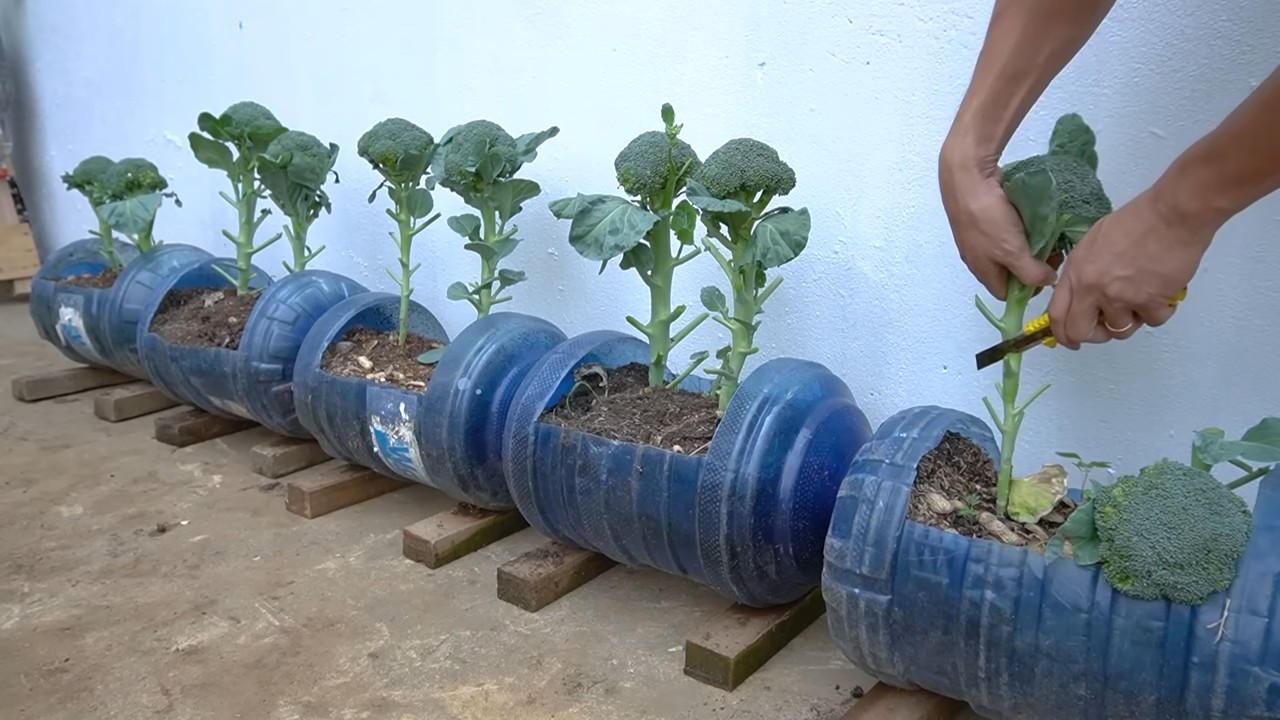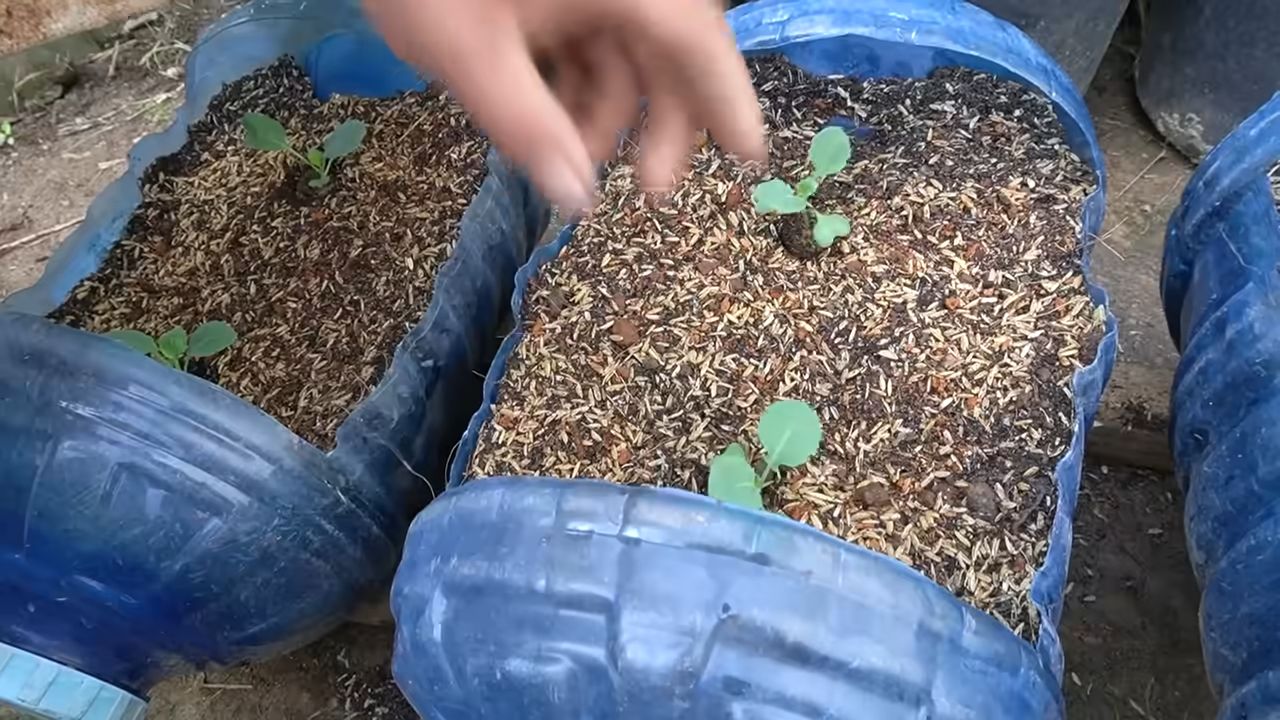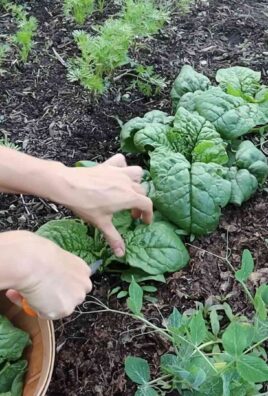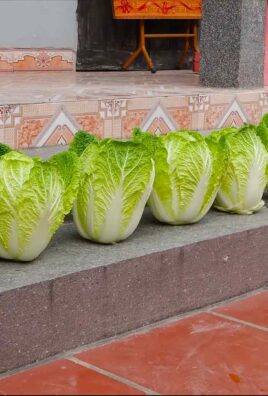Growing Broccoli at Home can seem daunting, but trust me, it’s more achievable (and rewarding!) than you might think. Have you ever dreamt of strolling into your backyard and harvesting crisp, green broccoli florets for dinner? Imagine the satisfaction of knowing exactly where your food comes from and that it’s bursting with freshness and nutrients. This isn’t just a pipe dream; it’s a reality you can create with a little know-how and some simple DIY techniques.
Broccoli, a member of the brassica family, has a rich history dating back to ancient Rome, where it was prized for its nutritional value and unique flavor. Today, it remains a staple in diets worldwide. But let’s be honest, supermarket broccoli can sometimes be a bit… underwhelming. That’s where the magic of home gardening comes in!
In this article, I’m going to share some of my favorite DIY tricks and hacks for successfully growing broccoli at home, even if you’re a complete beginner. We’ll cover everything from seed starting to pest control, ensuring you have a bountiful harvest. Why spend money on store-bought broccoli when you can cultivate your own organic, delicious supply right in your backyard? Let’s get our hands dirty and unlock the secrets to growing amazing broccoli!

Growing Broccoli at Home: A DIY Guide for Beginners
Hey there, fellow gardening enthusiasts! I’m so excited to share my experience and guide you through the process of growing your own broccoli at home. It’s surprisingly rewarding, and nothing beats the taste of freshly harvested, homegrown broccoli. Trust me, once you’ve tasted it, you’ll never want to go back to store-bought!
Choosing the Right Broccoli Variety
Before we dive into the nitty-gritty, let’s talk about broccoli varieties. There are tons of options out there, and choosing the right one for your climate and growing conditions is crucial. Here are a few popular choices:
* ‘Waltham 29’: This is a classic, reliable variety that’s known for its large, tight heads and good disease resistance. It’s a great all-around choice for beginners.
* ‘DiCicco’: If you’re looking for a variety that produces smaller, more numerous side shoots after the main head is harvested, ‘DiCicco’ is a fantastic option. It’s also relatively early-maturing.
* ‘Green Magic’: This variety is known for its heat tolerance, making it a good choice for warmer climates. It produces uniform, dark green heads.
* ‘ ক্যালব্রেস’: This is an heirloom variety that’s been around for ages. It’s known for its excellent flavor and good cold tolerance.
Consider your local climate and the length of your growing season when making your choice. Seed packets usually provide information about days to maturity, which can help you determine if a particular variety is suitable for your area.
Getting Started: Planting Broccoli
Okay, let’s get our hands dirty! Broccoli can be started indoors or directly sown into the garden, but I personally prefer starting indoors, especially if you live in an area with a short growing season.
Starting Seeds Indoors
1. Gather Your Supplies: You’ll need seed starting trays or small pots, seed starting mix (not regular potting soil!), broccoli seeds, a spray bottle, and a grow light (optional, but highly recommended).
2. Sow the Seeds: Fill your seed starting trays or pots with seed starting mix. Moisten the mix with the spray bottle – you want it damp, not soggy. Sow 2-3 broccoli seeds per cell or pot, about ¼ inch deep.
3. Provide Light and Warmth: Place the trays or pots in a warm location (around 70-75°F) and provide plenty of light. A grow light is ideal, but a sunny windowsill can also work. If using a windowsill, rotate the trays regularly to prevent the seedlings from becoming leggy.
4. Keep the Soil Moist: Water gently with the spray bottle whenever the soil surface feels dry. Avoid overwatering, as this can lead to damping off, a fungal disease that can kill young seedlings.
5. Thin the Seedlings: Once the seedlings have developed their first true leaves (the leaves that look like miniature broccoli leaves), thin them to one seedling per cell or pot. Snip off the weaker seedlings at the soil line with scissors.
6. Harden Off the Seedlings: About a week before you plan to transplant the seedlings into the garden, you’ll need to harden them off. This process gradually acclimates the seedlings to outdoor conditions. Start by placing the trays or pots outdoors in a sheltered location for a few hours each day, gradually increasing the amount of time they spend outside. Protect them from direct sunlight and strong winds.
Direct Sowing Broccoli Seeds
1. Prepare the Soil: Choose a sunny location with well-drained soil. Amend the soil with compost or other organic matter to improve its fertility and drainage.
2. Sow the Seeds: Sow the seeds directly into the garden, about ½ inch deep and 18-24 inches apart.
3. Water Regularly: Keep the soil consistently moist until the seeds germinate.
4. Thin the Seedlings: Once the seedlings have developed their first true leaves, thin them to one seedling per 18-24 inches.
Transplanting Broccoli Seedlings
Whether you started your seeds indoors or purchased seedlings from a nursery, transplanting them into the garden is a crucial step.
1. Choose the Right Time: Transplant broccoli seedlings when they are 4-6 weeks old and have developed several sets of true leaves. The best time to transplant is in the early morning or late afternoon, when the sun is less intense.
2. Prepare the Planting Site: Dig holes that are slightly larger than the root balls of the seedlings, spacing them 18-24 inches apart.
3. Carefully Remove the Seedlings: Gently remove the seedlings from their trays or pots, being careful not to damage the roots.
4. Plant the Seedlings: Place the seedlings in the holes and backfill with soil, gently firming the soil around the base of the plants. Make sure the top of the root ball is level with the surrounding soil.
5. Water Thoroughly: Water the seedlings thoroughly after transplanting.
6. Add Mulch: Apply a layer of mulch around the plants to help retain moisture, suppress weeds, and regulate soil temperature. Straw, shredded leaves, or wood chips are all good options.
Caring for Your Broccoli Plants
Once your broccoli plants are in the ground, it’s important to provide them with the care they need to thrive.
* Watering: Broccoli needs consistent moisture, especially during head formation. Water deeply and regularly, especially during dry spells. Aim for about 1-1.5 inches of water per week.
* Fertilizing: Broccoli is a heavy feeder, so it benefits from regular fertilization. Apply a balanced fertilizer every 2-3 weeks, following the instructions on the package. You can also side-dress with compost or aged manure.
* Weeding: Keep the area around your broccoli plants free of weeds, which can compete for nutrients and water. Hand-pull weeds regularly or use a hoe to cultivate the soil.
* Pest Control: Broccoli is susceptible to several pests, including cabbage worms, aphids, and flea beetles. Inspect your plants regularly for signs of infestation and take action promptly.
* Cabbage Worms: These green caterpillars can devour broccoli leaves. Handpick them off the plants or use Bacillus thuringiensis (Bt), a biological insecticide that’s safe for humans and beneficial insects.
* Aphids: These tiny, sap-sucking insects can weaken broccoli plants. Spray them off with a strong stream of water or use insecticidal soap.
* Flea Beetles: These small, jumping beetles can create tiny holes in broccoli leaves. Cover your plants with row covers to prevent flea beetles from reaching them.
* Disease Prevention: Broccoli can also be affected by several diseases, including black rot and clubroot. Choose disease-resistant varieties and practice good sanitation to prevent these problems.
* Black Rot: This bacterial disease can cause yellowing and browning of leaves. Remove infected leaves promptly and avoid overhead watering.
* Clubroot: This fungal disease can cause swollen, distorted roots. Amend the soil with lime to raise the pH and improve drainage.
Harvesting Your Broccoli
The moment you’ve been waiting for! Harvesting your own broccoli is incredibly satisfying.
1. Know When to Harvest: Broccoli is ready to harvest when the head is firm and tight, and the individual florets are still closed. The ideal head size will vary depending on the variety, but generally, you’re looking for a head that’s 6-8 inches in diameter.
2. Cut the Head: Use a sharp knife to cut the head from the plant, leaving about 4-6 inches of stem.
3. Encourage Side Shoots: After harvesting the main head, many broccoli varieties will produce smaller side shoots. Continue to water and fertilize the plants to encourage the growth of these side shoots.
4. Store Your Broccoli: Freshly harvested broccoli can be stored in the refrigerator for up to a week. To keep it fresh, wrap it loosely in a damp paper towel and place it in a plastic bag.
Troubleshooting Common Broccoli Problems
Even with the best care, you might encounter some problems while growing broccoli. Here are a few common issues and how to address them:
* Buttoning: This occurs when broccoli plants produce small, premature heads. It’s often caused by stress, such as lack of water or nutrients. Make sure your plants are getting enough water and fertilizer.
* Bolting: This happens when broccoli plants flower prematurely. It’s usually caused by hot weather. Choose heat-tolerant varieties and provide shade during the hottest part of the day.
* Yellowing Leaves: This can be caused by a variety of factors, including nutrient deficiencies, pests, or diseases. Inspect your plants carefully to determine the cause and take appropriate action.
Enjoying Your Homegrown Broccoli
Congratulations! You’ve successfully grown your own broccoli at home. Now

Conclusion
So, there you have it! Growing broccoli at home isn’t just a gardening project; it’s an investment in fresh, flavorful, and nutritious meals. We’ve walked through the steps, from selecting the right variety to warding off common pests, and hopefully, you’re feeling confident and ready to get your hands dirty.
Why is this DIY trick a must-try? Because the taste of homegrown broccoli is simply unparalleled. The supermarket varieties, while convenient, often lack the vibrant flavor and crisp texture that comes from harvesting your own broccoli at its peak ripeness. Plus, you have complete control over the growing process, ensuring that your broccoli is free from harmful pesticides and chemicals. You’re not just growing food; you’re cultivating a healthier lifestyle.
Beyond the superior taste and health benefits, growing your own broccoli is incredibly rewarding. There’s a unique satisfaction in nurturing a plant from seed to harvest, watching it thrive under your care. It’s a connection to nature that can be both therapeutic and educational, especially for children.
But the fun doesn’t stop there! Feel free to experiment with different broccoli varieties. Try growing Romanesco broccoli with its stunning fractal florets, or perhaps some purple sprouting broccoli for a splash of color in your garden. You can also explore companion planting to deter pests and improve the overall health of your broccoli plants. Consider planting herbs like rosemary or thyme nearby, or flowers like marigolds to attract beneficial insects.
Another variation to consider is succession planting. By planting new broccoli seeds every few weeks, you can ensure a continuous harvest throughout the growing season. This is especially useful if you have a large family or enjoy eating broccoli regularly.
Don’t be afraid to get creative with your broccoli recipes, too! From classic steamed broccoli with cheese sauce to roasted broccoli with garlic and parmesan, the possibilities are endless. You can even add your homegrown broccoli to soups, salads, stir-fries, and quiches for a boost of flavor and nutrition.
We strongly encourage you to give this DIY trick a try. Even if you’re a beginner gardener, you’ll be surprised at how easy and rewarding it can be. And once you’ve harvested your first head of homegrown broccoli, we’d love to hear about your experience! Share your photos, tips, and recipes with us in the comments below. Let’s create a community of broccoli-loving gardeners and inspire others to grow their own food.
Remember, growing broccoli at home is more than just a trend; it’s a sustainable and fulfilling way to connect with nature, nourish your body, and enjoy the freshest, most flavorful broccoli you’ve ever tasted. So, grab your seeds, get your hands dirty, and start growing today! You won’t regret it.
Frequently Asked Questions (FAQ)
What is the best time of year to plant broccoli?
The best time to plant broccoli depends on your climate. In general, broccoli is a cool-season crop, meaning it thrives in temperatures between 60°F and 70°F (15°C and 21°C). For spring crops, start seeds indoors 6-8 weeks before the last expected frost. Transplant seedlings outdoors 2-3 weeks before the last frost. For fall crops, start seeds indoors in mid-summer and transplant seedlings outdoors in late summer or early fall. Check your local frost dates for the most accurate timing.
How much sunlight does broccoli need?
Broccoli needs at least 6 hours of direct sunlight per day to thrive. Choose a planting location that receives full sun for optimal growth and head development. If you live in a particularly hot climate, some afternoon shade can be beneficial to prevent the broccoli from bolting (going to seed prematurely).
What kind of soil is best for growing broccoli?
Broccoli prefers well-drained, fertile soil with a pH between 6.0 and 7.0. Amend your soil with compost or other organic matter to improve drainage and fertility. A soil test can help you determine the pH of your soil and identify any nutrient deficiencies.
How often should I water my broccoli plants?
Broccoli plants need consistent moisture to thrive. Water deeply and regularly, especially during dry periods. Aim to keep the soil consistently moist but not waterlogged. Mulching around the plants can help retain moisture and suppress weeds.
What are some common pests and diseases that affect broccoli?
Common pests that affect broccoli include cabbage worms, aphids, flea beetles, and cabbage root maggots. Common diseases include clubroot, black rot, and downy mildew. Implement preventative measures such as crop rotation, companion planting, and using row covers to protect your plants. If pests or diseases do occur, treat them promptly with appropriate organic or chemical controls.
How do I know when my broccoli is ready to harvest?
Broccoli is ready to harvest when the central head is firm and the florets are tightly closed. The size of the head will vary depending on the variety, but generally, it should be about 6-8 inches in diameter. Use a sharp knife to cut the head from the plant, leaving a few inches of stem. After harvesting the central head, side shoots may develop, providing additional smaller heads for harvesting.
Can I grow broccoli in containers?
Yes, you can grow broccoli in containers, but you’ll need to choose a large container (at least 5 gallons) to accommodate the plant’s root system. Use a high-quality potting mix and ensure that the container has good drainage. Water regularly and fertilize as needed. Container-grown broccoli may require more frequent watering and fertilization than broccoli grown in the ground.
How do I prevent broccoli from bolting?
Bolting, or premature flowering, can occur when broccoli plants are exposed to stress, such as high temperatures or drought. To prevent bolting, choose heat-tolerant varieties, provide adequate water, and protect your plants from extreme temperatures. Mulching around the plants can also help keep the soil cool and moist.
What are some good companion plants for broccoli?
Good companion plants for broccoli include herbs like rosemary, thyme, and sage, which can help deter pests. Flowers like marigolds and nasturtiums can attract beneficial insects. Other beneficial companion plants include onions, garlic, and dill. Avoid planting broccoli near strawberries, tomatoes, or peppers, as these plants can compete for nutrients or attract pests.
How do I store harvested broccoli?
To store harvested broccoli, wrap it loosely in a plastic bag and store it in the refrigerator. Broccoli is best used within 3-5 days of harvesting. You can also freeze broccoli for longer storage. To freeze broccoli, blanch it in boiling water for 3-5 minutes, then plunge it into ice water to stop the cooking process. Drain well and store in freezer bags or containers.
Is homegrown broccoli more nutritious than store-bought broccoli?
Generally, homegrown broccoli can be more nutritious than store-bought broccoli. This is because homegrown broccoli is typically harvested at its peak ripeness and consumed shortly thereafter, preserving its nutrient content. Store-bought broccoli, on the other hand, may have been harvested several days or even weeks before it reaches the consumer, resulting in some nutrient loss. Additionally, you have control over the growing practices when you grow your own broccoli, ensuring that it is free from harmful pesticides and chemicals.




Leave a Comment